المُلخص التنفيذي
يتطلب التخطيط التشاركي مشاركة الجهات المعنية المهتمّةِ بالأمر، ويتضمن ذلك تحديد القيم والاهتمامات العامة وخلق نوع من التوافق العام وإجماع الآراء بشأن المبادرات المُخطط لها، ويتعلق ذلك أيضًا بالانتفاع من الكمية الهائلة من المعلومات والمعرفة التي تمتلكها الجهات المعنية في إيجاد حلول عملية وفعَّالة ومستدامة وقابلة للتنفيذ (CAP-NET 2008). يتمثَّل تحليل الجهات المعنية في عملية تحديد وتحليل الجهات المعنية والتخطيط لإشراكهم (WORLD BANK 1998)، ويوجد الكثير من الطرق المتعلقة بتحليل الجهات المعنية والتي تختلف في درجة التعقيد (انظر على سبيل المثال (see e.g. WORLD BANK 1998, NETSSAF 2008, CAP-NET 2005).
نستعرض هنا طريقة مكوَّنة من أربع خطوات يمكن تنفيذها بالكامل أو اختصارها وفقًا لما تتطلبه الحاجة: (1) تحديد الجهات المعنية ، (2) أهمية وتأثير الجهات المعنية ، (3) مصالح واهتمامات الجهات المعنية ،(4) الخطة الاستراتيجية للجهات المعنية.
بعد تحديد الجهات المعنية وأهميتهم في الخطوة التالية، يتم تقييم اهتمامتهم وتأثير هذه الاهتمامات على المشروع الذي تم التخطيط له.
تختلف اهتمامات الجهات المعنية بدرجة كبير فيما يتعلق بقضايا المياه والصرف الصحي. ونقصد بذلك أنه ستكون للجهات المعنية من مستويات مختلفة دوافع وتوقعات متعددة فيما يخص مشروع بعينه. قد يكون من الصعب تحديد اهتمامات الجهات المعنية بمختلف أنواعهم، خاصةً في حال كانوا "مستترين"، أو لو كانوا يعارضون الأهداف المعلنة صراحةً للمنظمات أوالمجموعات المشاركة. يمكن استنتاج الاهتمامات بطرح أسئلة مثل:
• ما هي توقعات الجهات المعنية من المشروع؟
• ما الفوائد المتوقع أن تجنيها الجهات المعنية؟
• ما الموارد التي يتمنى الشخص المعنيّ تخصيصها (أو عدم تخصيصها) للمشروع؟
• ما الاهتمامات والمصالح الأخرى للشخص المعني التي قد تتعارض مع المشروع؟
• كيف ينظر الشخص المعني للجهات المعنية الأخرى؟ (ODA 1995)
من المهم مناقشة توقعات واهتمامات الجهات المعنية والفوائد التي تعود عليهم بالإضافة إلى مخاوفهم أو التأثير السلبي للمبادرة عليهم – تباعًا، وذلك للأسباب التالية:
• لفهم ملاحظات الجهات المعنية ووجهة نظرهم.
• لتجنب نسيان أو إغفال الجوانب المهمة للجهات المعنية المشاركة أثناء تخطيط الإدارة المستدامة للمياه والصرف الصحي SSWM.
• لتعديل المبادرة بشكل أفضلٍ يراعي اهتمامات الجهات المعنية.
• لتجنب الفشل في التنفيذ وتجنب إغفال احتياجات ورغبات الجهات المعنية.
• لتركيز التخطيط و التنفيذ من البداية على احتياجات الجهات المعنية.
• لتوجيه المبادرة إلى الاتجاه الصحيح.
يوجد العديد من الاحتمالات الممكنة لمناقشة اهتمامات الجهات المعنية. تعتمد الطريقة المختارة على الطريقة التي تمت بها مناقشة الخطوات السابقة لتحليل الجهات المعنية وعلى النوع الذي تم اختياره للملاحظات والنظرة العامة فيما يتعلق بتحديد الجهات المعنيةوأهمية الجهات المعنية وتأثيرهم
في حال هيكلة وتنظيم الجهات المعنية في صورة خريطة مفتوحة فمن الممكن إضافة معلومات عن اهتماماتهم بلون آخر على الخريطة نفسها (انظر أيضًا مخطط Venn).
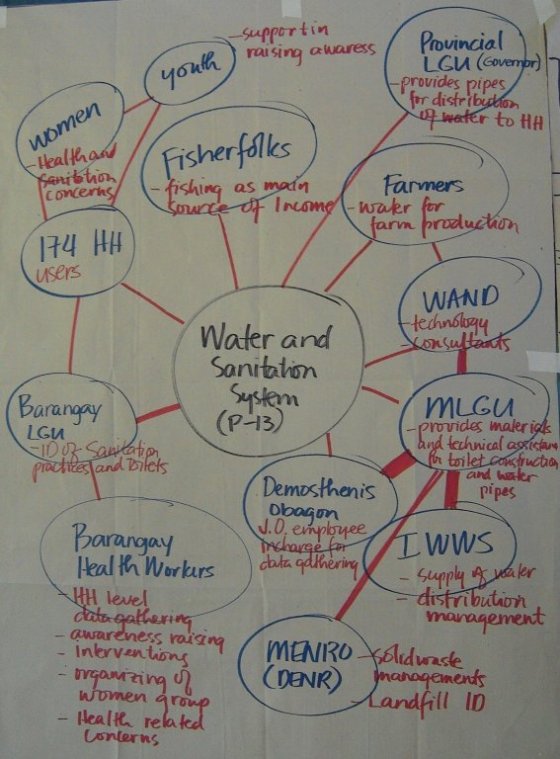
في هذا المثال، تمت إضافة التعليقات الخاصة بدور الجهات المعنية المختلفة باللون الأحمر. المصدر:KROPAC (2010)
ومن الطرق الأخرى لتحديد الاهتمامات وضع قائمة بجميع الجهات المعنية في جدول وإضافة المعلومات ذات الصلةإليها.
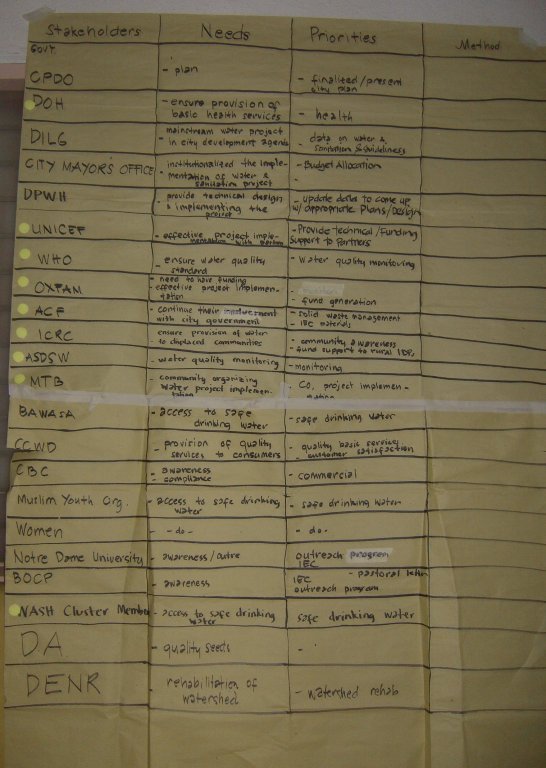
مثال على قائمة الجهات المعنية ويتضمن اهتماماتهم التي تم التعبير عنها -في هذه الحالة- ممثلة في الاحتياجات والأولويات. يمكن تحديد المعلومات الإضافية التي يتم إدراجها كلٌ على حدة في كل حالة. المصدر: KRPAC (2010)
في حال تم إجراء تحليل كيفيّ بغرض معرفة المزيد عن عامليّ الأهمية والتأثير، يمكن ببساطة إضافة المزيد من الصفوف للجدول الموجود بالفعل من أجل إدراج المزيد من المعلومات عن الجهات المعنية) انظر أيضًا تحديد الجهات المعنية
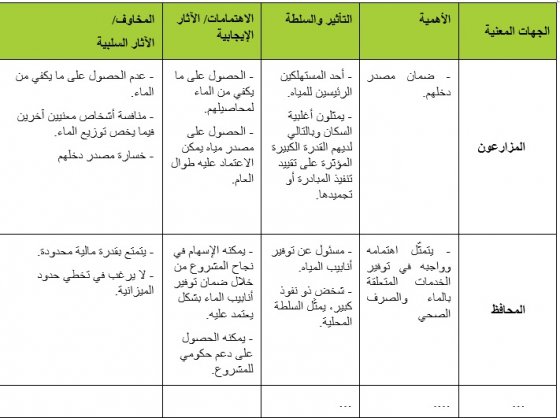
مثال على التحليل الكيفي للأهمية والتأثير والاهتمامات والمخاوف المتعلقة بمشروع إمدادات المياه على مستوىً محليّ. المصدر: LIENERT (2010)
Description
Stakeholders have very different interests with respect to sanitation and water issues. In particular, stakeholders from different levels will have various motives and expectations to a certain project. The specific interests of all types of stakeholders may be difficult to define, especially if they are "hidden", or in contradiction with the openly stated aims of the organisations or groups involved. Interests may be drawn out by asking:
- What are the stakeholder's expectations of the project?
- What benefits are there likely to be for the stakeholders?
- What resources will the stakeholder wish to commit (or avoid committing) to the project?
- What other interests does the stakeholder have which may conflict with the project?
- How does the stakeholder regard other stakeholders? (ODA 1995)
Discussing stakeholders’ expectations, interests and benefits and their concerns or the negative impact an initiative can have on them, respectively, is important for the following reasons:
- To understand stakeholders perception and their point of view
- To avoid forgetting important aspects of involved stakeholders during the planning of SSWM
- To better adjust an initiative regarding stakeholders interests
- To avoid implementation failures and to avoid disregarding the needs and desires of stakeholders
- To focus the planning and implementation right from the start on the needs of stakeholders
- To direct the initiative in the right directive.
There are several possibilities to discuss stakeholders’ interest. The method chosen depends on how former steps of stakeholder analysis were discussed and what kind of overviews for stakeholders identification and stakeholders importance and influence were chosen.
If one has structured the stakeholders as an open map, it is possible to add information about their interest in another colour on the same map (see also Venn diagrams).
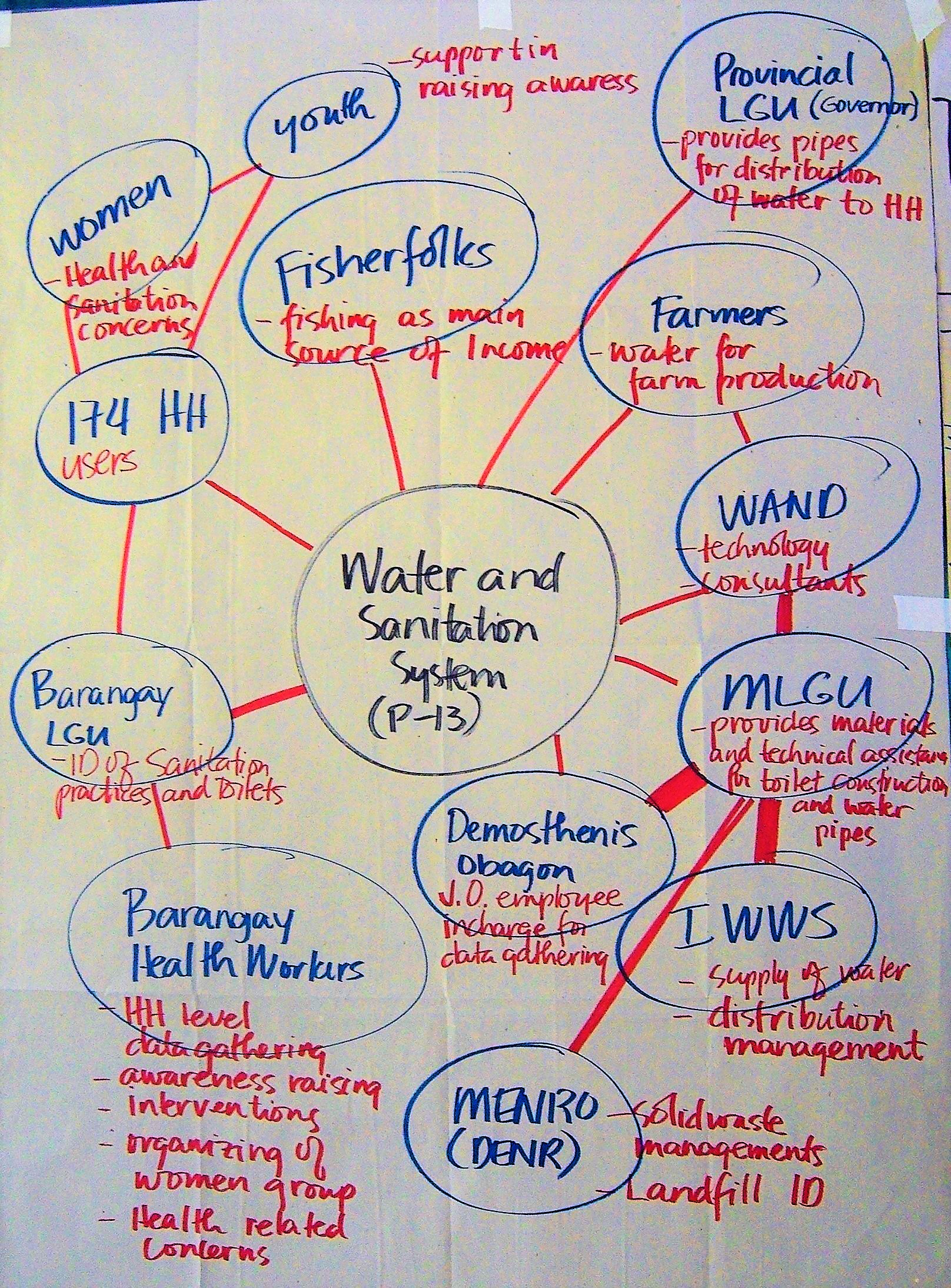
Another way to identify interests is to list all stakeholders in a table and add the relevant information.
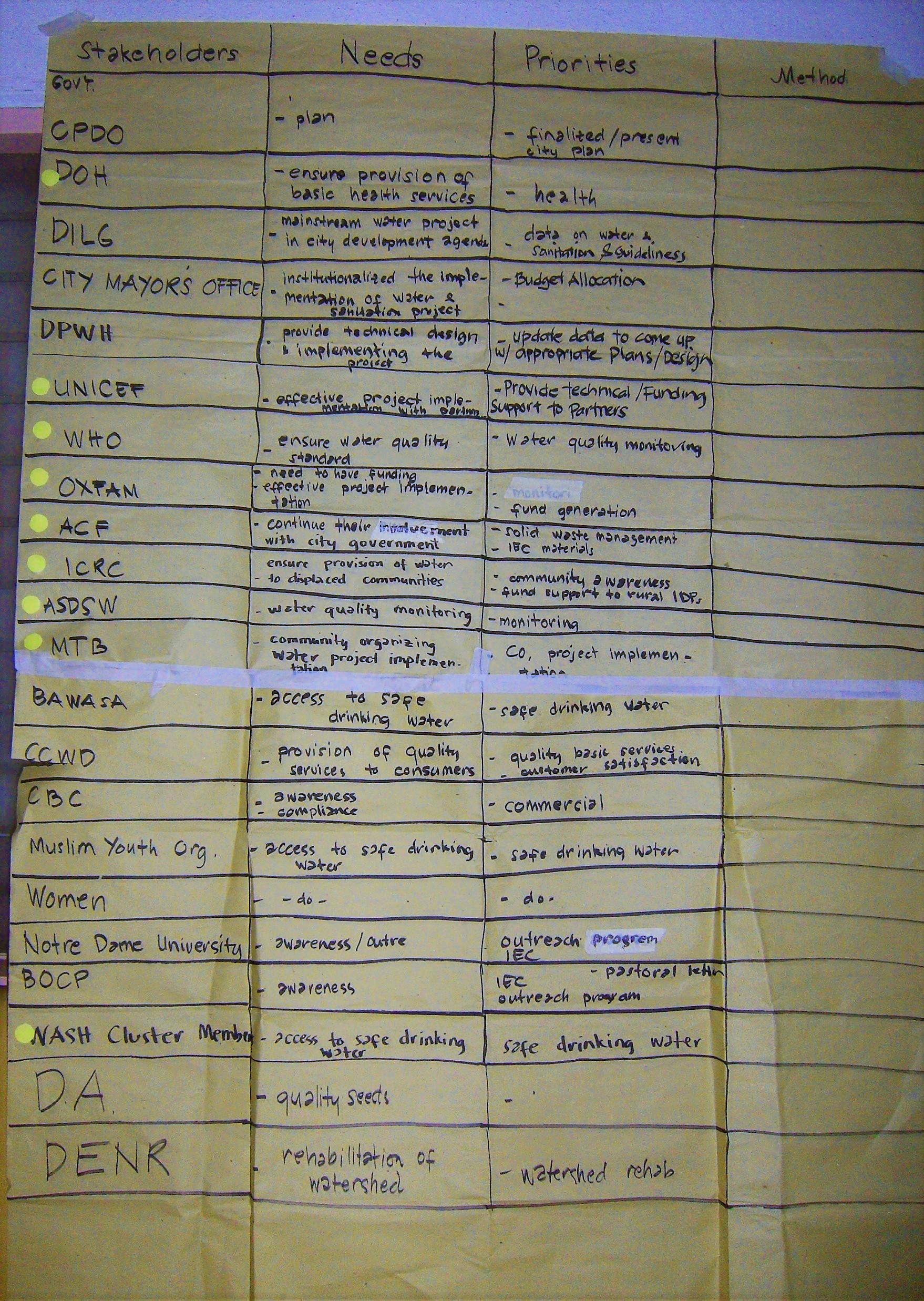
If a qualitative analysis has already been done in order to find out more about importance and influence, one can simply add more rows to the already existing table to include more information about the stakeholders. See also stakeholders identification.
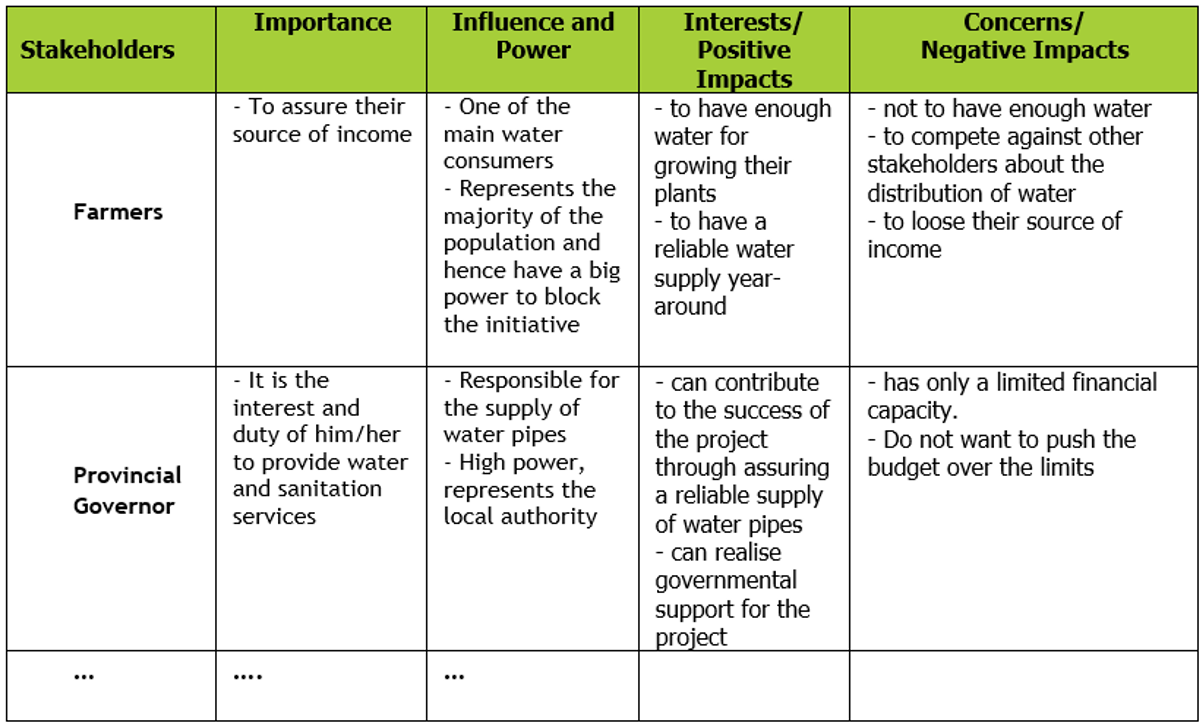
ملاحظة
تعتمد نوعية المعلومات المتوقع الحصول عليها من أجل التخطيط للإدارة المستدامة للمياه والصرف الصحي SSWMبدرجة كبيرة على سياق المبادرة، أحيانًا قد يكون من الكافي معرفة بعض الأمور عن الدور العام للجهات المعنية المختلفة في هذه المرحلة، وأحيانًا يستحق الأمر جمع ومناقشة جوانب أخرى مثل أهمية وتأثير الجهات المعنية أو حتى جوانب أخرى من التي قد تساعد في رفع كفاءة عملية التخطيط وتجنب الفشل في هذه المرحلة المبكرة من المشروع.
ينبغي تحديد درجة التفصيل المطلوبة للتحليل في سياق المشروع نفسه، ويعتمد هذا الأمر بشدة على الإطار الزمني المتاح للمبادرة.
Subscribe here to the new Sanitation and Water Entrepreneurship Pact (SWEP) newsletter. SWEP is a network of organizations joining hands to help entrepreneurs design and develop lasting water and sanitation businesses.
<ارجع إلى [9431-أهمية الجهات المعنية وتأثيرهم].
استمر في تحليل خطة استراتيجية الجهات المعنية>
راجع أيضًا:
خطوة 1: تحديد الجهات المعنية
يمكن إجراء تحليل مفصَّل آخر لاهتمامات الجهات المعنية لكل مشروع إلا أنّ الإطار الزمني المحدود قد يشكّل عائقًا أمام إجراء تحليل دقيق التفاصيل. علاوةً على ذلك في بعض الحالات عندما تكون طبيعة القضية محل الاهتمام ليست معقدة بدرجة كبيرة قد يكون من الملائم إدارة نقاش قصير حول اهتمامات الجهات المعنية مبدئيًا.
Integrated Water Resources Management Plans. Training Manual and Operational Guide
The Cap-Net manual is an introduction to essential parts of integrated water resource management (IWRM). Chapter 2 consists of management planning for IWRM, which provides good information about stakeholder process as well.
CAP-NET (2005): Integrated Water Resources Management Plans. Training Manual and Operational Guide. Pretoria: Cap-Net URL [Accessed: 30.06.2019]Integrated Water Resource Management for River Basin Organisations. Training Manual
Capacity Building for Ecological Sanitation
This publication deals with the educational aspects linked to ecologically sustainable sanitation, and contains extensive chapters on capacity building and knowledge management in the field of ecological sanitation.
UNESCO/IHP ; GTZ (2006): Capacity Building for Ecological Sanitation. Paris & Eschborn: German Agency for Technical Cooperation (GTZ) & International Hydrological Programme of UNESCO (UNESCO/IHP) URL [Accessed: 15.04.2019]NETSSAF Participatory Planning-Approach
This is the actual tutorial of the participative planning approach developed by NETSSAF, containing all the steps, sub-steps and case studies. It is freely available on the internet in French and English.
NETSSAF (2008): NETSSAF Participatory Planning-Approach. A tutorial for sustainable sanitation planning. Network for the Development of Sustainable Approaches for Large Scale Implementation of Sanitation in Africa (NETSSAF). [Accessed: 29.03.2010] PDFGuidance Note on how to do Stakeholder Analysis of Aid Projects and Programmes
This guidance note provides a step-by-step manual on how to do a stakeholder analysis. Effective strategies for stakeholder participation must be based on good analysis of individuals, groups, and institutions with an interest in a project.
ODA (1995): Guidance Note on how to do Stakeholder Analysis of Aid Projects and Programmes. London: Overseas Development Department (ODA) URL [Accessed: 30.06.2019]Carrying Out a Stakeholder Analysis
Participation and Social Assessment: Tools and Techniques
This resource kit aims to share information and experiences on participatory methods in the context of development cooperation. The primary focus concentrates on providing practical guidance and case examples.
RIETBERGEN-McCRACKEN, J. NARAYAN, D. WORLD BANK (1998): Participation and Social Assessment: Tools and Techniques. Washington: World Bank URL [Accessed: 10.05.2010]ﺩﻭﺭ ﺇﺩﺍﺭﺓ ﺍﻟﻌﻼﻗﺔ ﻣﻊ ﺃﺻﺤﺎﺏ المصلحة في ﺗﻔﻌﻴﻞ ﺃﺑﻌﺎﺩ ﺍﻟﺘﻨﻤﻴﺔ المستدامة في المؤسسة ﺍﻻﻗﺘﺼﺎﺩﻳﺔ. ﻘﺴﻨﻄﻴﻨﺔ
تسعي هذه الورقة الحالية الي تحديد دور ادارة العلاقة مع الاطراف اصحاب المصلحة في اسقاط ابعاد التنمية المستدامة علي مستوي المؤسسة الاقتصادية
حمزة ﺭﻣﻠﻲ,إسماعيل ﺯﺣﻮﻁ (2012): ﺩﻭﺭ ﺇﺩﺍﺭﺓ ﺍﻟﻌﻼﻗﺔ ﻣﻊ ﺃﺻﺤﺎﺏ المصلحة في ﺗﻔﻌﻴﻞ ﺃﺑﻌﺎﺩ ﺍﻟﺘﻨﻤﻴﺔ المستدامة في المؤسسة ﺍﻻﻗﺘﺼﺎﺩﻳﺔ. ﻘﺴﻨﻄﻴﻨﺔ . URL [Accessed: 25.08.2017]Language: Arabic
محاولة جادة لتأطير نظرية اصحاب المصالح في إدارة دراسات الأعمال . مجلة ﺍﻟﻌﻠﻮﻡ ﺍﻻﻗﺘﺼﺎﺩﻳﺔ ﻭﺍﻻﺩﺍﺭﻳﺔ .المجلد 13 /ﻉ48/ ﻟﺴﻨﺔ2007 .جامعة بغداد .العراق
التطبيق الناجح لحوارات اصحاب المصلحة.
هي دراسة مترجمة تحوي المهارات الأساسية الرامية لتنفيذ المشاورات وعلاقات التعاون بشكل ناجح. يقدم هذا الكتاب إرشادات توجيهية وعملية للجهات المسؤلة حول تحفيز التغيير في القطاع الحكومي و القطاع الخاص والمجتمع المدني
ﺒﻴﺘرا ﻜوﻨﻜل, ﺴﻴﻠﻔﻴﻨﻪ ﺠﻴرﻻخ, ﻓﻴرا ﻓرﻴﺞ (2014): التطبيق الناجح لحوارات اصحاب المصلحة.. URL [Accessed: 30.08.2017]Language: Arabic
:ﻗﻴﺎﺱ ﺭﻀﺎ ﺒﻌﺽ ﺃﺼﺤﺎﺏ ﺍﻟﻤﺼﺎﻟﺢ . ﺩﺭﺍﺴﺔ ﻤﻴﺩﺍﻨﻴﺔ ﻓﻲ ﺍﻟﺸﺭﻜﺔ ﺍﻟﻌﺎﻤﺔ ﻟﺼﻨﺎﻋﺔ ﺍﻷﺩﻭﻴﺔ ﻓﻲ ﻨﻴﻨﻭﻯ. مجلة ﺗﻨﻤﻴﺔ ﺍﻟﺮﺍﻓﺪﻳﻦ ﺍﻟﻌﺪﺩ ١٠٩مجلد ٣٤ ﻟﺴﻨﺔ ٢٠١٢ .ﺹ[٢٥٦-٢٣٣.ﻛﻠﻴﺔ ﺍﻹﺩﺍﺭﺓ ﻭﺍﻻﻗﺘﺼﺎﺩ.ﺟﺎﻣﻌﺔ الموصل
هي دراسة ميدانية في الشركة العامة لصناعة الأدوية في نينوى تهدف الي تقييم رضا بعض أصحاب المصالح وتوضح الاطر المنهجية واهداف البحث وفرضيات البحث وأدواته وثباته
ﻋﻼﺀ الجبوري, ﻋﻠﻲ سالم أحمد (2012): :ﻗﻴﺎﺱ ﺭﻀﺎ ﺒﻌﺽ ﺃﺼﺤﺎﺏ ﺍﻟﻤﺼﺎﻟﺢ . ﺩﺭﺍﺴﺔ ﻤﻴﺩﺍﻨﻴﺔ ﻓﻲ ﺍﻟﺸﺭﻜﺔ ﺍﻟﻌﺎﻤﺔ ﻟﺼﻨﺎﻋﺔ ﺍﻷﺩﻭﻴﺔ ﻓﻲ ﻨﻴﻨﻭﻯ. مجلة ﺗﻨﻤﻴﺔ ﺍﻟﺮﺍﻓﺪﻳﻦ ﺍﻟﻌﺪﺩ ١٠٩مجلد ٣٤ ﻟﺴﻨﺔ ٢٠١٢ .ﺹ[٢٥٦-٢٣٣.ﻛﻠﻴﺔ ﺍﻹﺩﺍﺭﺓ ﻭﺍﻻﻗﺘﺼﺎﺩ.ﺟﺎﻣﻌﺔ الموصل. URL [Accessed: 25.08.2017]Good Practices in Participatory Mapping
This report explores the power of participatory mapping. Covering a range of techniques, intermediaries, tools and impacts, it is shown how a systematic approach could contribute to addressing conflict-related issues and improving community ownership in sustainable environmental and natural resource management.
IFAD (2009): Good Practices in Participatory Mapping. Rome: International Fund for Agricultural Development (IFAD) URL [Accessed: 04.05.2010]Guidance Note on how to do Stakeholder Analysis of Aid Projects and Programmes
This guidance note provides a step-by-step manual on how to do a stakeholder analysis. Effective strategies for stakeholder participation must be based on good analysis of individuals, groups, and institutions with an interest in a project.
ODA (1995): Guidance Note on how to do Stakeholder Analysis of Aid Projects and Programmes. London: Overseas Development Department (ODA) URL [Accessed: 30.06.2019]Integrated Water Resources Management Plans. Training Manual and Operational Guide
The Cap-Net manual is an introduction to essential parts of integrated water resource management (IWRM). Chapter 2 consists of management planning for IWRM, which provides good information about stakeholder process as well.
CAP-NET (2005): Integrated Water Resources Management Plans. Training Manual and Operational Guide. Pretoria: Cap-Net URL [Accessed: 30.06.2019]Capacity Building for Ecological Sanitation
This publication deals with the educational aspects linked to ecologically sustainable sanitation, and contains extensive chapters on capacity building and knowledge management in the field of ecological sanitation.
UNESCO/IHP ; GTZ (2006): Capacity Building for Ecological Sanitation. Paris & Eschborn: German Agency for Technical Cooperation (GTZ) & International Hydrological Programme of UNESCO (UNESCO/IHP) URL [Accessed: 15.04.2019]NETSSAF Participatory Planning-Approach
This is the actual tutorial of the participative planning approach developed by NETSSAF, containing all the steps, sub-steps and case studies. It is freely available on the internet in French and English.
NETSSAF (2008): NETSSAF Participatory Planning-Approach. A tutorial for sustainable sanitation planning. Network for the Development of Sustainable Approaches for Large Scale Implementation of Sanitation in Africa (NETSSAF). [Accessed: 29.03.2010] PDFParticipation and Social Assessment: Tools and Techniques
This resource kit aims to share information and experiences on participatory methods in the context of development cooperation. The primary focus concentrates on providing practical guidance and case examples.
RIETBERGEN-McCRACKEN, J. NARAYAN, D. WORLD BANK (1998): Participation and Social Assessment: Tools and Techniques. Washington: World Bank URL [Accessed: 10.05.2010]How to Create a Regional Dynamic to Improve Local Water Supply and Sanitation Services in Small Towns in Africa
Small towns, the size of which can vary from between 3,000 and 30,000 inhabitants, have specific characteristics as they tend to be situated midway between rural and urban. Too small to benefit from those opportunities available to large urban centers, particularly in terms of competencies for developing and managing services, they are also too large to be able to accommodate those community-based approaches prevalent in rural areas. This guide defines the specific issues and challenges facing small towns. A methodology for developing a regional strategy for water and sanitation is provided, as well as the courses of action to be followed to facilitate access to finance and mobilize the expertise required to provide back-up support and training to local authorities and service operators.
VALFREY-VISSER, B. (2010): How to Create a Regional Dynamic to Improve Local Water Supply and Sanitation Services in Small Towns in Africa. (= Six Methodological Guides for a Water and Sanitation Services' Development Strategy , 2 ). Cotonou and Paris: Partenariat pour le Développement Municipal (PDM) and Programme Solidarité Eau (pS-Eau) URL [Accessed: 19.10.2011]Getting communities engaged in water and sanitation projects: participatory design and consumer feedback
Community engagement in water and sanitation service delivery is key for ensuring project sustainability and accountability. This Topic Brief looks at community engagement approaches used by WSUP in three cities within the African Cities for the Future (ACF) programme: Antananarivo (Madagascar), Kumasi (Ghana) and Maputo (Mozambique). The Topic Brief highlights some of the key challenges, and ends with practical recommendations for programme managers about how to engage low-income communities in the design of water supply and sanitation projects.
WSUP (2013): Getting communities engaged in water and sanitation projects: participatory design and consumer feedback. London: Water & Sanitation for the Urban Poor (WSUP) URL [Accessed: 30.06.2019]ﻣﺸﺎﺭﻛﺔ ﺃﺻﺤﺎﺏ ﺍﻟﻤﺼﻠﺤﺔ ﻓﻲ ﺇﺩﺍﺭﺓ ﺍﻟﻤﻴﺎﻩ ﺍﻟﺠﻮﻓﻴﺔ. ﺟﺎﻣﻌﺔ ﻗﻨﺎﺓ ﺍﻟﺴﻮﻳﺲ.مصر.
هي مذكرة توضح مشاركة اصحاب المصالح في ادارة المياه الجوفية وانشطة اصحاب المصالح وما هي الاليات المؤسسية لمشاركة أصحاب المصلحة
البنك الدولي (2006): ﻣﺸﺎﺭﻛﺔ ﺃﺻﺤﺎﺏ ﺍﻟﻤﺼﻠﺤﺔ ﻓﻲ ﺇﺩﺍﺭﺓ ﺍﻟﻤﻴﺎﻩ ﺍﻟﺠﻮﻓﻴﺔ. ﺟﺎﻣﻌﺔ ﻗﻨﺎﺓ ﺍﻟﺴﻮﻳﺲ.مصر.. URL [Accessed: 25.08.2017]Language: Arabic
Strategy Development for Successful Implementation of Ecological Sanitation Approaches in Sri Lanka using Stakeholder Analysis. Report 3 of 3 from "Evaluation of the Appropriateness of Ecological Sanitation in Relation to the Social, Cultural and Economic
The presented stakeholder analysis provides the necessary information to develop strategies for the successful implementation of ecological sanitation approaches in Sri Lanka.
WINDBERG (2009): Strategy Development for Successful Implementation of Ecological Sanitation Approaches in Sri Lanka using Stakeholder Analysis. Report 3 of 3 from "Evaluation of the Appropriateness of Ecological Sanitation in Relation to the Social, Cultural and Economic. Paris: UNICEF URL [Accessed: 18.08.2010]Stakeholder Analysis
This short PowerPoint presentation explains in a brief way how to do a stakeholder analysis and also contains empty tables that can be directly used for analysing stakeholders.
PUBLIC SECTOR IMPROVEMENT FACILITY (n.y): Stakeholder Analysis. URL [Accessed: 30.06.2019]Carrying out a stakeholder analysis
This is a very practical, concise and easy to understand set of online guidelines for planning and running training courses. Although the training approaches and techniques described here are based soundly on the sciences of pedagogy and education, they also reflect the practical side of field work in the developing world.

